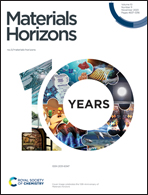Dilute Gd hydroxycarbonate particles for localized spin qubit integration†
Abstract
Molecular spins are considered as the quantum hardware to build hybrid quantum processors in which coupling to superconducting devices would provide the means to implement the necessary coherent manipulations. As an alternative to large magnetically-dilute crystals or concentrated nano-scale deposits of paramagnetic molecules that have been studied so far, the use of pre-formed sub-micronic spherical particles of a doped Gd@Y hydroxycarbonate is evaluated here. Particles with an adjustable number of spin carriers are prepared through the control of both particle size and doping. Bulk magnetic properties and continuous wave and time-domain-EPR spectroscopy show that the Gd spins in these particles are potential qubits with robust quantum coherence. Monolayers of densely-packed particles are then formed interfacially and transferred successfully to the surface of Nb superconducting resonators. Alternatively, these particles are disposed at controlled localizations as isolated groups of a few particles through Dip-Pen Nanolithography using colloidal organic dispersions as ink. Altogether, this study offers new material and methodologies relevant to the development of viable hybrid quantum processors.



 Please wait while we load your content...
Please wait while we load your content...